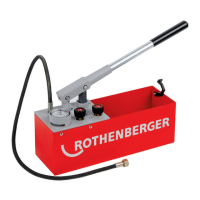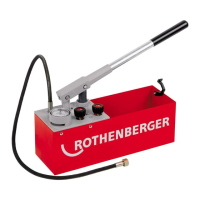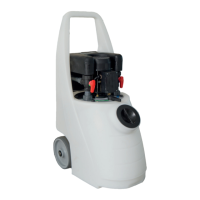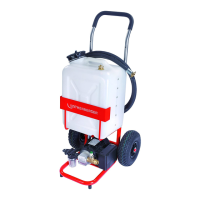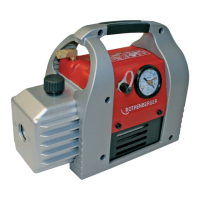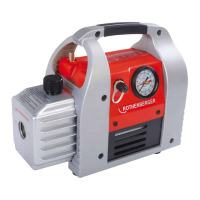Do you have a question about the Rothenberger RP50 and is the answer not in the manual?
Connect pressure hose, open V1, close V2 for initial setup.
Remove air from installation by pumping, then close vents.
Continue pumping until the specified test pressure is achieved.
Close valve V1 to isolate the system once pressure is reached.
If pressure is too high, briefly open V2 to reduce it.
Keep tank and pump clean; clean the filter if it becomes clogged.
Apply water repellent grease to the piston regularly, avoiding damage.
Congratulates user, highlights RP-50's high quality design and operation.
Details unique features like dual shut-off valves, robust piston, and durable tank.
Explains the necessity of testing pipe installations for liquid-tightness.
Emphasizes reading and retaining instructions for safe operation.
Study controls before use; do not modify the RP-50 for other purposes.
Use only specified liquids; check for damaged parts before operation.
Only original Rothenberger parts should be used for maintenance.
Connect pressure hose to equipment, open V1, close V2.
Open purge points, pump liquid until air is purged, then close vents.
Continue pumping until the required test pressure has been reached.
Close valve V1 to isolate the system after reaching the test pressure.
If test pressure is exceeded, open valve V2 until required pressure is attained.
If no leaks, no pressure drop; open both V1 and V2 at test completion.
Keep tank and pump clean; clean suction pipe filter if clogged.
Grease piston periodically with water repellent grease; avoid piston damage.
Lists name, code, dimensions, weight, tank volume, piston volume, and outlet connection.
Specifies testing fluid (Water, oil) and maximum temperature (50° C / 120° F).
States the maximum pressure the pump can handle (60 bar / 860 psi / 6 Mpa).
Identifies the pressure hose component of the pump.
Identifies the V1 shut-off valve.
Identifies the V2 purge valve.
Identifies the locking hook component.
Identifies the handle of the pump.
Identifies the tank component of the pump.
Connect pressure hose, open V1, close V2 for initial setup.
Remove air from installation by pumping, then close vents.
Continue pumping until the specified test pressure is achieved.
Close valve V1 to isolate the system once pressure is reached.
If pressure is too high, briefly open V2 to reduce it.
Keep tank and pump clean; clean the filter if it becomes clogged.
Apply water repellent grease to the piston regularly, avoiding damage.
Congratulates user, highlights RP-50's high quality design and operation.
Details unique features like dual shut-off valves, robust piston, and durable tank.
Explains the necessity of testing pipe installations for liquid-tightness.
Emphasizes reading and retaining instructions for safe operation.
Study controls before use; do not modify the RP-50 for other purposes.
Use only specified liquids; check for damaged parts before operation.
Only original Rothenberger parts should be used for maintenance.
Connect pressure hose to equipment, open V1, close V2.
Open purge points, pump liquid until air is purged, then close vents.
Continue pumping until the required test pressure has been reached.
Close valve V1 to isolate the system after reaching the test pressure.
If test pressure is exceeded, open valve V2 until required pressure is attained.
If no leaks, no pressure drop; open both V1 and V2 at test completion.
Keep tank and pump clean; clean suction pipe filter if clogged.
Grease piston periodically with water repellent grease; avoid piston damage.
Lists name, code, dimensions, weight, tank volume, piston volume, and outlet connection.
Specifies testing fluid (Water, oil) and maximum temperature (50° C / 120° F).
States the maximum pressure the pump can handle (60 bar / 860 psi / 6 Mpa).
Identifies the pressure hose component of the pump.
Identifies the V1 shut-off valve.
Identifies the V2 purge valve.
Identifies the locking hook component.
Identifies the handle of the pump.
Identifies the tank component of the pump.
| Brand | Rothenberger |
|---|---|
| Model | RP50 |
| Category | Water Pump |
| Language | English |
